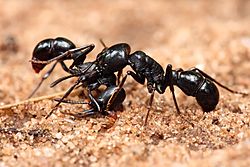Apocrita facts for kids
Quick facts for kids Apocrita |
|
|---|---|
 |
|
| Plectroctena sp. | |
| Scientific classification | |
| Kingdom: | |
| Phylum: | |
| Class: | |
| Order: | |
| Suborder: |
Apocrita
|
| Superfamilies | |
|
|
Apocrita is a very large group of insects. It includes many familiar creatures like ants, bees, and wasps. This group is a suborder within the larger order called Hymenoptera. The other main group in Hymenoptera is the Symphyta.
Apocrita are considered some of the most advanced insects in their order. There are more than 100,000 different types, or species, of Apocrita found all over the world. They play many important roles in nature, from pollinating plants to controlling other insect populations.
Contents
What Makes Apocrita Special?
Apocrita insects have a unique body shape. They have a very narrow "wasp-waist" (called a petiole) that connects their front body (thorax) to their back body (abdomen). This narrow waist allows them to move their abdomen very freely. This is helpful for stinging, laying eggs, or building nests.
Another key feature is how their wings are connected. When they fly, their front and back wings hook together. This makes their wings act like one large wing, which helps them fly more efficiently.
Two Main Groups: Aculeata and Parasitica
The Apocrita suborder is divided into two main groups:
- Aculeata: This group includes insects that can sting. The stinger is actually a modified egg-laying tube (ovipositor). This group includes all ants, bees, and many wasps.
- Parasitica: This group includes insects that are mostly parasitic. This means they lay their eggs on or inside other insects. Their young then feed on the host insect. Many tiny wasps, like ichneumons and chalcids, belong to this group.
Aculeata: Stinging Insects
The Aculeata group is well-known for its ability to sting.
- Bees are famous for collecting nectar and pollen. They are very important pollinators for many plants. Some bees, like honey bees, live in large social colonies.
- Ants are highly social insects. They live in organized colonies with different jobs for each ant, like workers, soldiers, and a queen. Ants are found almost everywhere on Earth.
- Wasps are a diverse group. Some wasps are social, building large paper nests. Others are solitary, meaning they live alone. Many wasps hunt other insects, helping to control pest populations.

Parasitica: Nature's Pest Controllers
The Parasitica group includes many types of wasps that are parasitic.
- These wasps lay their eggs on or inside other insects, like caterpillars or aphids.
- When the eggs hatch, the young wasp larvae eat the host insect.
- This natural process helps to keep the populations of other insects in check. Many of these parasitic wasps are very small, sometimes just a few millimeters long.
Life Cycle and Habits
Apocrita insects go through a complete metamorphosis. This means they have four distinct life stages: egg, larva, pupa, and adult.
- The egg hatches into a larva, which is usually worm-like and spends its time eating and growing.
- The larva then changes into a pupa, a resting stage where it transforms into an adult.
- Finally, the adult emerges, ready to reproduce.
Many Apocrita, especially ants, bees, and some wasps, show complex social behaviors. They live in organized colonies with different roles for each member. This social structure allows them to build impressive nests, find food efficiently, and defend their colony.
See also
 In Spanish: Apocrita para niños
In Spanish: Apocrita para niños

